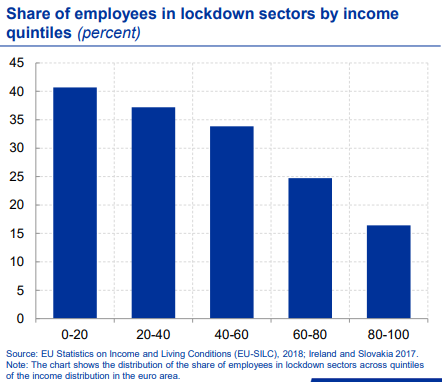Pandemic and Lockdowns have disproportionately affected lower-income households
By Samuel Rz, founding editor at Westphalian Times. Make sure to subscribe to my substack below to get live breaking news and analyses in your mailbox. Follow Westphalian Times for honest journalism.
Lockdowns caused by the COVID-19 pandemic have disproportionately affected lower-income households and amplified inequalities that will likely be felt for years to come.
A presentation by Isabel Schnabel, member of the European Central Bank executive Board titled “Unequal scars – distributional consequences of the pandemic” show that the pandemic and the lockdowns experienced throughout 2020 have disproportionately affected lower-income households.
The macroeconomic consequences of the COVID pandemic are now well understood. Public debt is expected to rise dramatically in nearly every country (figure 1) while the gross domestic product is expected to contract. GDP contraction will be mitigated by fiscal stimulus (figure 2) but will remain however alarming.
The lockdowns in Europe (and similar conclusions would be reached for North America) has disproportionately affected lower-income households. Over 40% of employees in lockdown sectors were from the lower income quintile. Barely 15% of the top income quintile were employed in lockdown sectors (figure 3).
While the lower income quintile in Germany, Spain and France was on aggregate unable to put aside any savings during the COVID pandemic, the top income quintile was able to save an average of 20,000 euros ($23683.62 USD) and postpone over 10,000 euros ($11841.81 USD) in spending (figure 4).
Students from high income households achieved higher academic performance following the closure of the schools in March. Students from low and middle income households experienced a drop in academic performance (figure 5).
Just a few weeks ago, we learned that the aggregate wealth of Billionaires increased by more than 25% over the pandemic, now totaling $10.2 trillion.
With governments closing down small businesses and restaurants in many jurisdictions across Europe and North America, it is not surprising that consumers turn to giants like Amazon or restaurants chains that have a well-implemented delivery service.
The aggregation of wealth and the many disadvantages that lockdowns have imposed on lower-income households should be a key analysis criteria when reviewing government policies on public health. While the contagion of the virus should be curtailed, other factors should also be taken into consideration.
Students from lower-income households who are now receiving lower grades due to their subpar studying environment will be penalized for years to come when seeking employment. Such divides will further amplify the inequalities that we are facing today.






